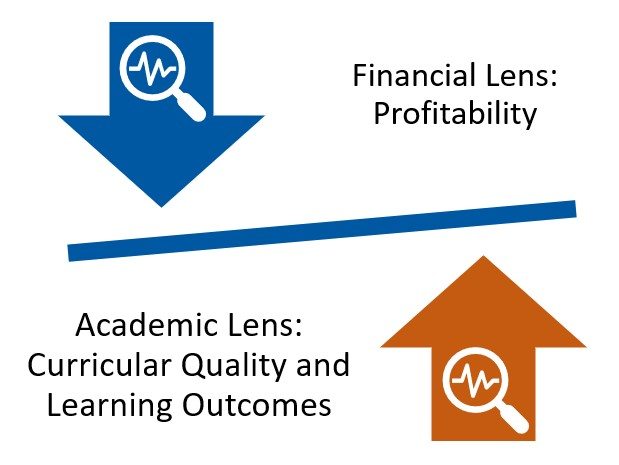Publication of the academic catalog for the 2024-2025 academic year may seem a long way off right now, but now is the time to start thinking about an academic portfolio review to ensure that the catalog represents an optimal academic program mix for your institution.
Conducting regular reviews of the academic portfolio means that program choices will be made based on real data that will help define which programs are thriving, which are holding their ground, and which are struggling. Failure to regularly review programs may mean that program decisions could be made that do not align with the institution’s strategic goals. The academic portfolio (the “product” mix) is the core of any college’s or university’s strategy and should represent the best investment of an institution’s finite resources. Optimizing that portfolio is accomplished by viewing programs through both an academic lens, considering factors such as curricular quality and learning outcomes, and a financial lens, comparing the profitability of the institution’s different program offerings.
Academic Portfolio Review Should Balance Financial and Academic Perspectives

The financial lens
The financial analysis of programs is not intended to lead to “decision-making by the numbers”; rather, the financial considerations must be balanced by academic quality to ensure that the institution maintains its value. Programmatic financial performance should not, however, be ignored when defining the academic portfolio. A decision to keep an underperforming program means a decrease in the resources available to support a growing program or add new program offerings to the institution’s portfolio.
Financial analysis should look at each program as a profit center, allocating revenue, direct expenses, and overhead to each according to such factors as program type (e.g., doctoral, master’s, bachelor’s), resources needed for each program type (based, for example, on the number of credit hours needed for each program type), and the number of students enrolled in the program. Enrollment trends also provide an initial lens to view outcomes of the financial analysis. A program that is unprofitable and facing enrollment declines should be viewed differently from one that is unprofitable but seeing increasing enrollment.
New programs are generally excluded from this analysis with the understanding that it takes time (typically, approximately two to three years) for a new program to become profitable. That said, however, new programs should be vigilantly monitored relative to metrics established in the business planning process (e.g., enrollment or marketing spend) in an effort to avoid allowing the new program to limp along too long with inadequate enrollment and financial performance.
The academic lens
From the perspective of academic quality, programs can be weighed against a rubric of attributes that measure program sustainability. This rubric might vary, but should typically include such attributes as:
- Student outcomes. Depending on the program type, this may include metrics such as percentage of undergraduate students accepted into graduate or professional programs, or the number of graduates employed within a certain period (e.g., six months) following graduation.
- Alignment with institution’s strategic trajectory. The measure of this attribute should be weighted according to metrics such as likelihood of the program’s longevity and whether it is considered a current and necessary offering.
- Options for program expansion. This metric would favor programs that could provide a platform to start similar, ancillary programs that could share existing resources such as faculty expertise or labs.
- Comparison to competing programs. Depending on the program and the institution, the competitive analysis could be local (e.g., within a 50-mile radius), regional (within a state or multi-state region), or national.
- Availability of internal resources. This metric should consider the level of internal resources available to run the program.
While the financial analysis is largely quantitative, the academic analysis will be more qualitative, based on both available program data and on input from key institution stakeholders. The academic analysis provides the color and context that balance the outcomes of the financial analysis. Combined, the two analyses provide necessary data and context that can help counter “the loudest voices in the room” scenario often experienced when program decisions are made.
Making timely decisions
If an academic portfolio review is initiated now, administrators and faculty leaders will have the relevant information in their hands later this fall, when the academic catalog for the coming academic year is compiled. Without this information, the institution is likely to simply maintain the status quo. The resulting deferral of decisions on programs that could be putting an unnecessary burden on the institution’s resources could result in avoidable limitations on resources to invest in growing or new programs. Further, should the analysis point to the difficult decision to cut programs, such a decision will be supported by quantification of the associated costs of closure as compared to the costs of continuing an underperforming program. When those ongoing costs are greater, especially if there are no compelling arguments for the academic value of the program, closure decisions, as difficult as they are, can be made more directly.
Once a full portfolio review has been completed, the institution also will be positioned to act with greater agility going forward. Portfolio reviews typically rely on a three-year historical review of data. Programs that are succeeding today can continue another three years before their next review. Programs that are borderline or struggling, but are continued, should be revisited bi-annually to determine whether their metrics have improved or deteriorated.
Academic portfolio review does not constrain an institution’s strategy; instead, it ensures that the institution’s strategy is grounded in an informed and realistic view of available institutional resources and academic strengths. A strong academic program mix is fundamental to an institution’s continued success.










